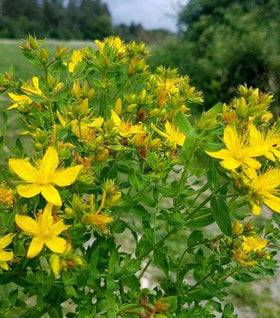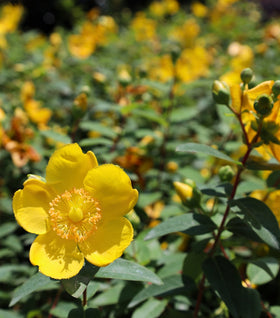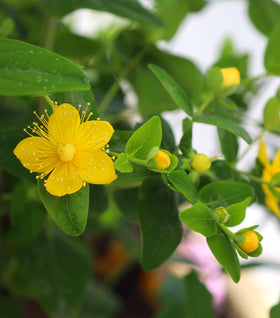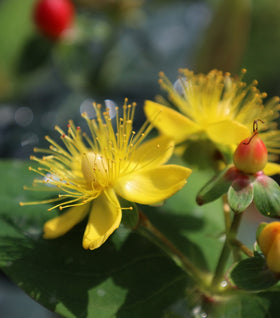St. John's Wort for Sale Online
Hypericum Plants, commonly known as St. John's Wort, are attractive perennial plants that have been useful as mass ground covers for many years. St. John's Wort has come a long way as a plant family. There are now Hypericums that are considered to be small shrubs that don't spread out as Hypericum Calycinum does. These newly introduced shrubs are best used in landscape beds or even naturalized plantings.
All St. Johns Wort's produce bright yellow flowers beginning in early summer, and many rebloom through the summer and fall. The newer varieties have seed pods that are very colorful and keep this plant interesting even when they're not in flower.
Using Creeping St. Johns Wort in the Garden
St. Johns Wort plants are adaptable to varying sunlight levels from full sun to part shade and are also considered to be drought tolerant. They produce hundreds of the famous star-shaped yellow flowers that butterflies and other pollinator insects adore. All Hypericum varieties are deer resistant, so they make great groundcovers where deer eat others. Hypericums are also often seen growing where few other plants have been successful such as hillsides or underneath trees where it competes well with the shallow tree roots.
Many commercial landscapes are starting to receive Hypericum plants in the tough areas in parking lots and sidewalk strips where little else will grow.
Types of St. Johns Wort Plants
Hypericum Calycinum: This is the best Groundcover Hypericum. It's not invasive and deer resistant.cIt remains evergreen throughout the winter and is very drought tolerant. It can be used in full sun areas. And into the part sun. It spreads through underground runners and develops a healthy root system. It can be cut to the ground in the spring if the foliage begins to look haggard after an extreme winter. It can reach 15 inches tall.
Hypericum Hidcote: St. Johns Wort Hidcote produces the same large yellow flowers as Hypericum calycinum in May and June but on a taller plant at 2 to 3 feet. The semi-evergreen leaves can form a low hedge as well as effective ground cover. It also flowers slightly later than Calycinum.
Hypericum Sunny Boulevard: Sunny Boulevard St. Johns Wort is native to North America and ideal for shrub borders, perennial gardens, or for use as a hedge. You may prune your Sunny Boulevard St. John's Wort Shrub. It looks even more magnificent in its native, "wild" form. It is deer resistant and remains evergreen even though some of the harshest northern winters.
Hypericum Red Fame: The bright yellow late spring flowers are followed by even bright fire-engine red berries that pair perfectly with autumn’s oranges, maroons, and yellows. The berries are often cut and used in floral arrangements. It also looks great in mixed containers on patios and decks.
Hypericum Pumpkin: Hypericum Pumpkin is covered with yellow flowers in the spring and is followed by large clusters of bright-orange berries in the fall. Also, perfect additions to cut autumn floral arrangements or planted in mixed containers.
Why is Hypericum called St. Johns Wort?
The word 'wort' is an old English word meaning 'plant' and does not refer to skin disorders. Hypericums have been associated with John the Apostle for hundreds of years because it blooms on or around the Feast of St. John in midsummer.
During the Middle Ages, Europeans believed that hypericum plants possessed magical powers and used them in their homes to ward of evil spirits. Today, hypericum extracts are a popular medicine used to treat depression and other similar medical disorders. Hypericum literally translates to "Above Picture' as it was often hung above pictures.




